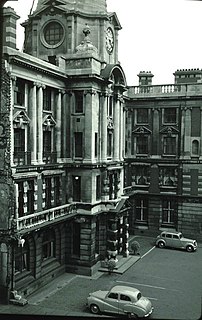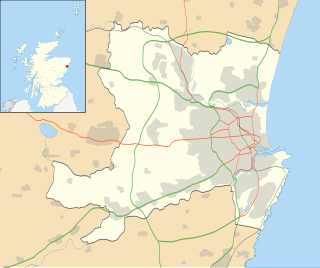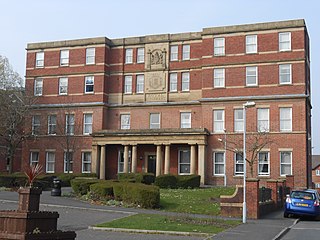Royal Infirmary may refer to a number of hospitals in the United Kingdom:

A hospital is a health care institution providing patient treatment with specialized medical and nursing staff and medical equipment. The best-known type of hospital is the general hospital, which typically has an emergency department to treat urgent health problems ranging from fire and accident victims to a sudden illness. A district hospital typically is the major health care facility in its region, with a large number of beds for intensive care and additional beds for patients who need long-term care. Specialized hospitals include trauma centers, rehabilitation hospitals, children's hospitals, seniors' (geriatric) hospitals, and hospitals for dealing with specific medical needs such as psychiatric treatment and certain disease categories. Specialized hospitals can help reduce health care costs compared to general hospitals. Hospitals are classified as general, specialty, or government depending on the sources of income received.

The United Kingdom, officially the United Kingdom of Great Britain and Northern Ireland but more commonly known as the UK or Britain, is a sovereign country lying off the north-western coast of the European mainland. The United Kingdom includes the island of Great Britain, the north-eastern part of the island of Ireland and many smaller islands. Northern Ireland is the only part of the United Kingdom that shares a land border with another sovereign state—the Republic of Ireland. Apart from this land border, the United Kingdom is surrounded by the Atlantic Ocean, with the North Sea to the east, the English Channel to the south and the Celtic Sea to the south-west, giving it the 12th-longest coastline in the world. The Irish Sea lies between Great Britain and Ireland. With an area of 242,500 square kilometres (93,600 sq mi), the United Kingdom is the 78th-largest sovereign state in the world. It is also the 22nd-most populous country, with an estimated 66.0 million inhabitants in 2017.
- England
- Bristol Royal Infirmary
- Derbyshire Royal Infirmary
- Doncaster Royal Infirmary
- Huddersfield Royal Infirmary
- Hull Royal Infirmary
- Leicester Royal Infirmary
- Liverpool Royal Infirmary
- Manchester Royal Infirmary
- North Staffordshire Royal Infirmary, see University Hospital of North Staffordshire
- Sheffield Royal Infirmary

Hull Royal Infirmary is one of the two main hospitals for Kingston upon Hull. It is situated on Anlaby Road, just outside the city centre, and is run by Hull and East Yorkshire Hospitals NHS Trust.

The Leicester Royal Infirmary (LRI) is a National Health Service hospital in Leicester, England. It is located to the south-west of the city centre. It has an accident and emergency department and is managed by of the University Hospitals of Leicester NHS Trust.

The Liverpool Royal Infirmary was a health facility in Pembroke Place in Liverpool, England. The building is now used by the University of Liverpool.
- Scotland
- Aberdeen Royal Infirmary
- Dumfries and Galloway Royal Infirmary
- Dundee Royal Infirmary (now closed)
- Edinburgh Royal Infirmary
- Glasgow Royal Infirmary
- Perth Royal Infirmary
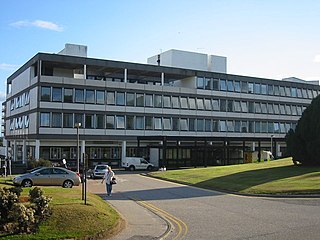
Aberdeen Royal Infirmary (ARI) is the largest hospital in the Grampian area, located on the Foresterhill site in Aberdeen, Scotland. ARI is a teaching hospital with around 900 inpatient beds, offering tertiary care for a population of over 600,000 across the North of Scotland. It offers all medical specialities with the exception of heart and liver transplants. It is managed by NHS Grampian.

Dumfries and Galloway Royal Infirmary is the main hospital in Dumfries, Scotland. The hospital is managed by NHS Dumfries and Galloway.
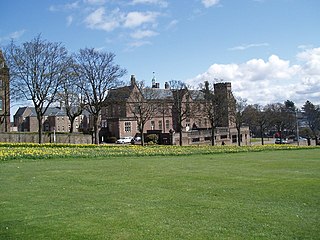
Dundee Royal Infirmary, often shortened to DRI, was a major teaching hospital in Dundee, Scotland. Until the opening of Ninewells Hospital in 1974, Dundee Royal Infirmary was Dundee's main hospital. It was closed in 1998, after 200 years of operation.
- Wales

The Bristol Royal Infirmary, also known as the BRI, is a large teaching hospital situated in the centre of Bristol, England. It has links with the nearby University of Bristol and the Faculty of Health and Social Care at the University of the West of England, also in Bristol.
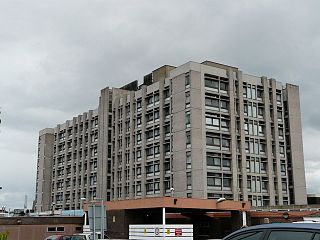
Doncaster Royal Infirmary is a district general hospital of 800 beds, located in Doncaster, South Yorkshire, England managed by Doncaster and Bassetlaw Teaching Hospitals NHS Foundation Trust

The Huddersfield Royal Infirmary is a hospital situated in the English town of Huddersfield, part of Calderdale and Huddersfield NHS Foundation Trust. It is situated in the suburb of Lindley and provides general services, emergency services and some specialist services.

